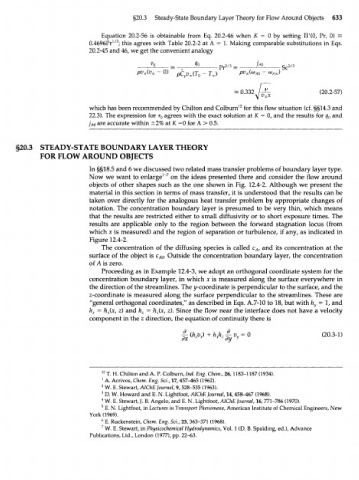Page 653 - Bird R.B. Transport phenomena
P. 653
§20.3 Steady-State Boundary Layer Theory for Flow Around Objects 633
Equation 20.2-56 is obtainable from Eq. 20.2-46 when К = 0 by setting П'(0, Pr, 0) =
0.4696Pr ; this agrees with Table 20.2-2 at Л = 1. Making comparable substitutions in Eqs.
1/3
20.2-45 and 46, we get the convenient analogy
Л1Ъ
~ \J) ~Q у ГГ _ т 1 \
pV x \V x p"V x
= 0.332 J ^ (20.2-57)
which has been recommended by Chilton and Colburn for this flow situation (cf. §§14.3 and
12
22.3). The expression for т agrees with the exact solution at К = 0, and the results for q and
0
0
j A 0 are accurate within ±2% at К =0 for Л > 0.5.
§20.3 STEADY-STATE BOUNDARY LAYER THEORY
FOR FLOW AROUND OBJECTS
In §§18.5 and 6 we discussed two related mass transfer problems of boundary layer type.
Now we want to enlarge " on the ideas presented there and consider the flow around
1 7
objects of other shapes such as the one shown in Fig. 12.4-2. Although we present the
material in this section in terms of mass transfer, it is understood that the results can be
taken over directly for the analogous heat transfer problem by appropriate changes of
notation. The concentration boundary layer is presumed to be very thin, which means
that the results are restricted either to small diffusivity or to short exposure times. The
results are applicable only to the region between the forward stagnation locus (from
which x is measured) and the region of separation or turbulence, if any, as indicated in
Figure 12.4-2.
The concentration of the diffusing species is called c , and its concentration at the
A
surface of the object is c . Outside the concentration boundary layer, the concentration
A0
of A is zero.
Proceeding as in Example 12.4-3, we adopt an orthogonal coordinate system for the
concentration boundary layer, in which x is measured along the surface everywhere in
the direction of the streamlines. The y-coordinate is perpendicular to the surface, and the
z-coordinate is measured along the surface perpendicular to the streamlines. These are
"general orthogonal coordinates/' as described in Eqs. A.7-10 to 18, but with h = 1, and
y
h = h (x, z) and h = hXx, z). Since the flow near the interface does not have a velocity
x x z
component in the z direction, the equation of continuity there is
£(h zv x) + hA-^v y = 0 (20.3-1)
12 Т. Н. Chilton and A. P. Colburn, Ind. Eng. Chem., 26,1183-1187 (1934).
1 A. Acrivos, Chem. Eng. ScL, 17,457-465 (1962).
2 W. E. Stewart, AIChE Journal 9, 528-535 (1963).
3 D. W. Howard and E. N. Lightfoot, AIChE Journal, 14, 458-467 (1968).
4 W. E. Stewart, J. B. Angelo, and E. N. Lightfoot, AIChE Journal, 16, 771-786 (1970).
5 E. N. Lightfoot, in Lectures in Transport Phenomena, American Institute of Chemical Engineers, New
York (1969).
6 E. Ruckenstein, Chem. Eng. Sci., 23, 363-371 (1968).
7 W. E. Stewart, in Physicochemical Hydrodynamics, Vol. 1 (D. B. Spalding, ed.), Advance
Publications, Ltd., London (1977), pp. 22-63.

